So, you’ve got some hefty equipment that needs hauling? It’s no small task, we can tell you that much. Getting that massive machinery from point A to B involves a lot more than just loading it up and hitting the road. That’s why we’re here, though, to guide you through the thick and thin of it all.
In this article, we’ll break down the essentials of heavy equipment transport. We’re talking about how to get your gear ready for the journey, the lowdown on choosing the right trailer, and the 411 on post-delivery procedures.
We’ve got some sage advice and a couple of handy tips up our sleeves too, and we’ll wrap it all up by answering some of the most frequently asked questions out there.
Sounds like a plan? Let’s roll.
Understanding Heavy Equipment Transport
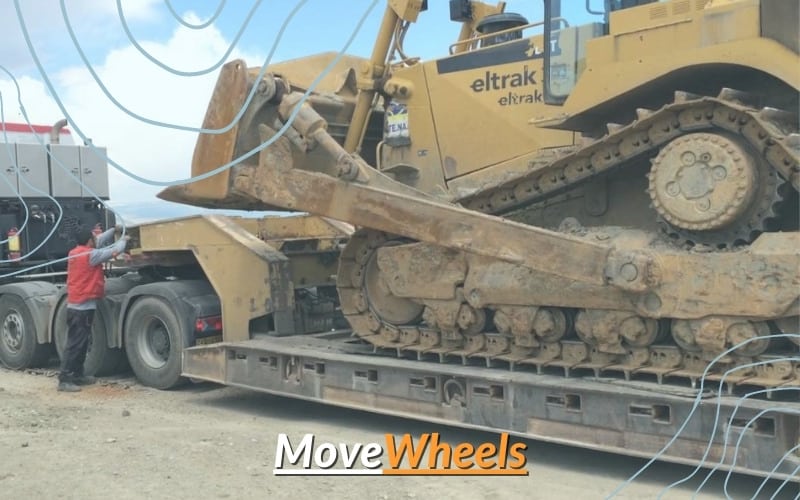
When we talk about heavy equipment transport, we’re talking about more than just a Sunday drive down the interstate. It’s a specialized field that involves the transport of substantial, often oversized machinery and equipment. This can range from bulldozers and backhoes used in construction, to combines and tractors in farming, all the way to industrial machinery used in factories.
Heavy equipment transport requires a lot of know-how. You’ve got to consider things like weight limitations, dimensions, and potential route restrictions. It’s a logistical puzzle, ensuring the equipment gets from point A to point B safely and efficiently.
And it’s not just about getting the gear on a trailer and calling it a day. The transport process starts long before the rubber meets the road. You’ve got to prep the equipment, select the right trailer for the job, and then make sure everything is strapped down and secure.
But don’t worry, you’re not alone in this. Companies like MoveWheels have got your back. With years of experience in the “heavy equipment transport” game, we know a thing or two about “hauling heavy machinery”. We’ll help you navigate the process, making it as smooth and easy as a drive through the countryside.
Now, before we get into the nitty-gritty details, let’s start with the first step: getting your heavy equipment ready for transport. Buckle up, it’s going to be a hefty ride.
Guidelines for Preparing Your Heavy Equipment for Transport
Okay, so you’re ready to haul some hefty gear across the country. But before we can get that show on the road, there’s a bit of prep work that needs to be done. You can’t just wave a magic wand and expect everything to be ready. Here’s how to get your heavy equipment primed for the journey:
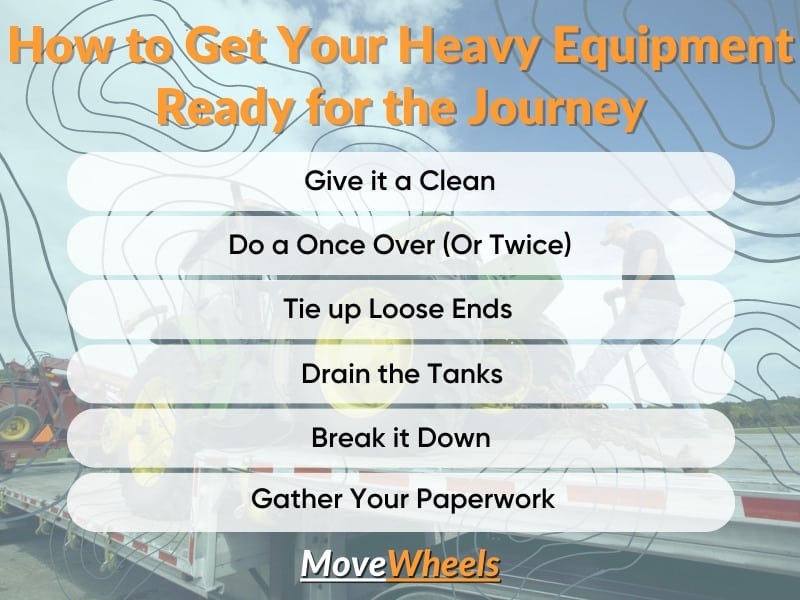
Now, this might seem like a lot of work, but remember, it’s all about ensuring your heavy equipment transport goes off without a hitch. And when you team up with pros like MoveWheels, you’ve got an experienced partner to guide you through each step. We’re here to help you get your heavy machinery from A to B, with no surprises or speed bumps along the way. Next up, let’s talk trailers.
Insights on How to Choose the Most Suitable Trailer
You’ve got your heavy equipment prepped and ready for transport. The next puzzle to crack is choosing the right trailer for the job. Not all trailers are created equal, and the type of trailer you pick can make or break the efficiency of your heavy equipment transport. Let’s dive into the details.
Decoding Trailer Types for Heavy Machinery
There’s no one-size-fits-all when it comes to trailers. Here are the usual suspects you’ll encounter when shipping heavy machinery:
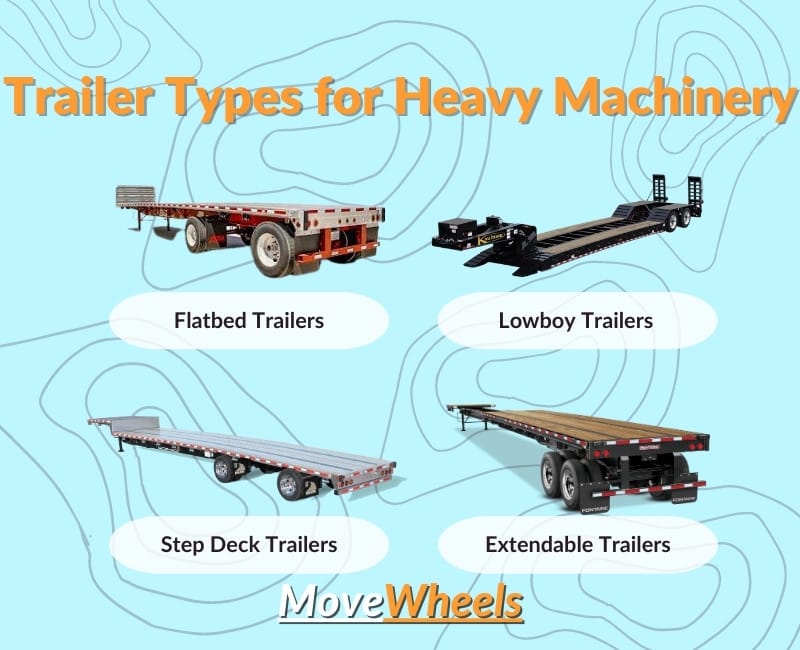
Factors to Ponder When Choosing a Trailer
There’s more to picking a trailer than just matching it with your machinery. Here are a few key considerations to keep in mind:
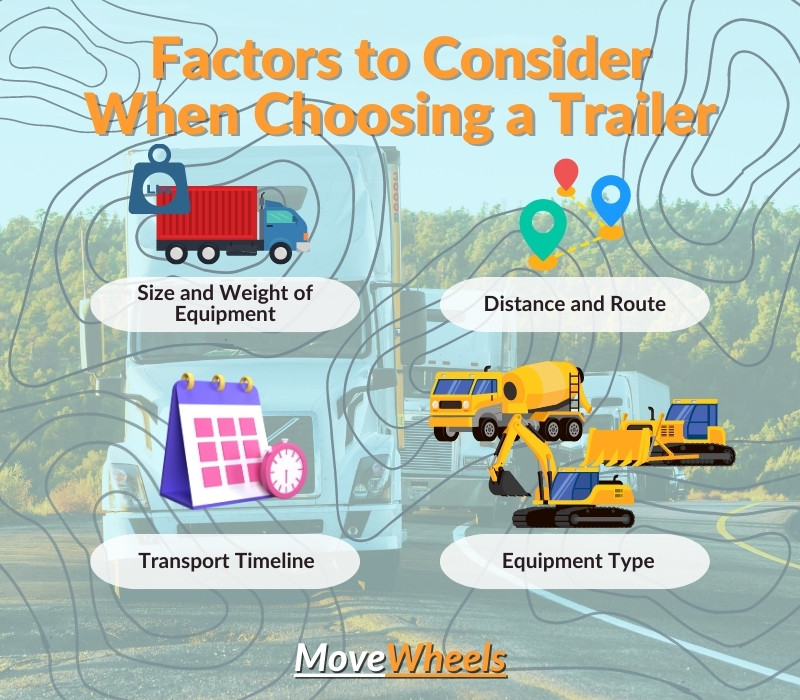
Deciphering the trailer puzzle isn’t for the faint of heart, but you don’t have to go it alone. The team at MoveWheels, armed with our deep understanding of “how heavy equipment shipping works”, is here to lend a hand.
Our seasoned professionals can guide you through the selection process, helping you find the best fit for your specific transport needs. We’ll provide all the support you need, ensuring your heavy equipment gets where it needs to go, safely and efficiently.
Picked your trailer? Great! Let’s move on to what happens once your heavy machinery hits the road. Buckle up for the next stage of our journey.
Post-Transport Procedures
Whew! Your heavy equipment has made the long haul and is now safely at its destination. But hang on, before you pop the champagne, there’s some post-transport work to do. Follow these steps to wrap things up neatly:
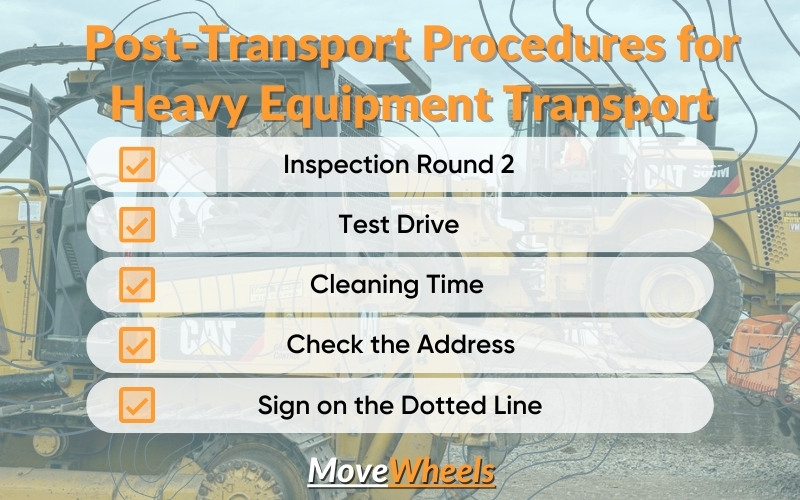
Following these steps ensures you close the heavy equipment transport chapter properly, leaving no room for issues down the line. Remember, the team at MoveWheels.com isn’t just here to help you during the transport, we’re also here to guide you through these post-transport steps. Our goal is to make your heavy equipment shipping process as seamless and hassle-free as possible.
Alright, with the equipment unloaded and checked, we’re almost at the end of our journey. But before we sign off, here are a few final tips and tricks.
Final Steps and Tips
Your heavy equipment transport journey doesn’t stop at just choosing the right trailer and prepping your machinery. To ensure a seamless, hassle-free experience, consider these final steps and handy tips:
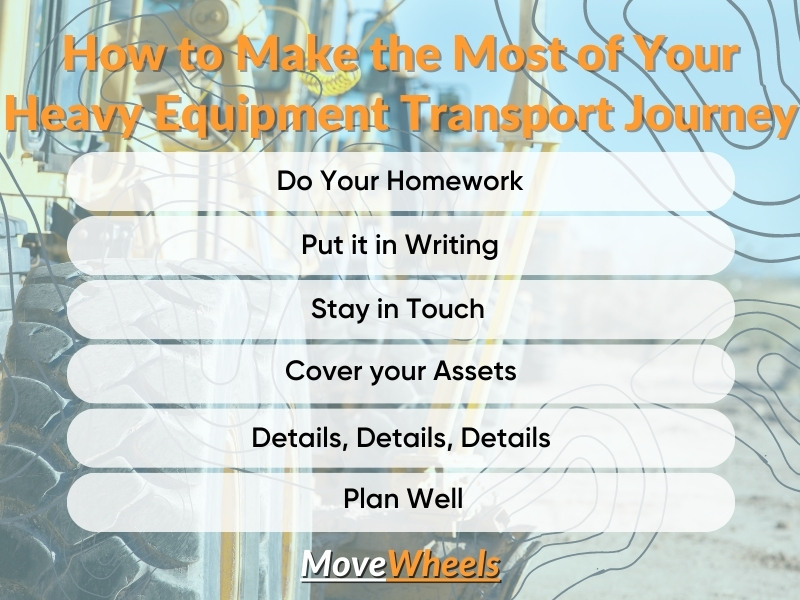
Keeping these final pointers in mind will ensure your heavy equipment transport goes off without a hitch. We hope this guide has provided valuable insights into the world of heavy equipment transport.
Heavy equipment transport might seem like a mountain of a task, but with the right knowledge and assistance, it doesn’t have to be daunting. From understanding the nitty-gritty of the transport process, preparing your heavy machinery, choosing the right trailer, to post-transport procedures, and helpful final tips – every step of the way counts.
While it’s true that it involves a fair amount of planning and preparation, the process is definitely manageable, especially when you’ve got a trustworthy partner like MoveWheels.com to guide you. Remember, at the end of the day, your heavy equipment is more than just machinery – it’s an investment, and transporting it safely is our priority.
So, the next time you’ve got heavy equipment to move, don’t stress. You’re now equipped with the know-how to make the journey smooth and secure. And remember, we’re always here to lend a hand and get your heavy machinery where it needs to be – safe and sound.
Stay safe, and happy hauling!
FAQ
What type of documentation do I need to provide when transporting heavy equipment?
Documentation typically includes proof of ownership, registration, and any necessary permits. The specifics can vary depending on your location and the type of equipment, so it’s best to check with your transport company or local regulations.
What if my heavy equipment exceeds the weight limits for standard trailers?
If your heavy equipment exceeds the weight limits for standard trailers, it might need to be transported using specialized trailers like a lowboy or extendable trailer. Always provide accurate information to your transport company, so they can make the best decision.
Are there any additional charges for heavy equipment transport?
The cost of transporting heavy equipment can vary depending on a variety of factors, including the weight and size of the equipment, the distance of transport, and the type of trailer used. Always get a detailed quote from your transport company.
Do I need to be present during the pickup and delivery of my equipment?
It’s advisable for you or a representative to be present during both pickup and delivery to ensure everything goes smoothly and to sign off on any paperwork.
Can I load my heavy equipment with materials or tools for the transport?
Generally, it’s not recommended to load your equipment with anything during transport. This can affect the weight and balance of the equipment and may lead to complications.
What happens if there are unforeseen delays during transport?
While every effort is made to adhere to the schedule, unforeseen delays due to weather, traffic, or other circumstances can happen. Your transport company should communicate with you about any changes to the schedule.
Similiar Articles
- How to Ship Multiple Cars at Once: Family Moves, Small Fleets, and Bulk Discounts
- How One of the Top RV Shipping Companies Stands Out
- Best Online Car Buying Platforms – The Ultimate Guide
- The Definitive 2025 Guide to the Cheapest Ways to Ship a Car
- Costco Auto Transport Made Easy – Ship Your Car Hassle‑Free with MoveWheels
- Is Your RV Ready for Spring Travel? Pre-Transport Checklist
- Open Vehicle Transport: How it Works and How Much It Costs in 2024
- Secure and Sophisticated: Your Complete Guide to Enclosed Auto Transport with MoveWheels
- New Year, New Motorcycle: Top Motorcycles` Choice among Americans in 2024
- How Vehicle Type Impacts Transportation Costs: From Cars to Heavy Equipment
